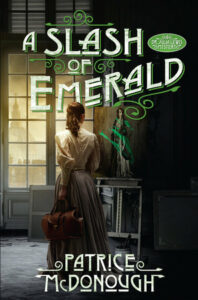Dr. Julia Lewis #2
This new series featuring a female doctor in Victorian England is one to enjoy. Protagonist Dr. Julia Lewis began the first book called out on a criminal case, and by this one, the second, the police have quickly learned that although she may be female, she can help them solve difficult problems. Of course she also has a regular practice, but the focus of the books is her work with the authorities, specifically one very attractive yet damaged Inspector.
While I loved the first installment, it was jam packed, as are many scene setting series debuts, while this sequel benefits greatly from a more focused plot. As the story opens, Dr. Julia is called in to perform a pelvic exam on a woman who was assaulted while walking close to an army barracks. Under British law at the time, the woman was required to be examined for infectious disease, while the man was not, and Inspector Tennant asks Julia to perform this exam, thinking it will be easier for the victim when conducted by a member of the same sex. She agrees.
The other precipitating event is a massive skating accident on a frozen pond at Regent’s Park. Among those who went into the frigid water is a man whose sister is a friend of Julia’s, and since Julia is on the scene, she’s pressed into an exam, drawing her into the saga of the Allingham family. Her waterlogged patient is an important art critic and publisher, with a painter sister recently returned from Paris, and a wife mourning her several miscarriages. Puzzlingly, the man dies by his own hand shortly after surviving the accident, apparently having put poisonous green paint (which at the time was loaded with arsenic) in his own drink.
Because of the successful resolution of Julia’s last case, his suspicious sister asks her to investigate. Since Julia and Inspector Tennant are now friends, she has a smoother path forward as their inquiries take them through the lively London art world of the time, one in which larger than life painters like Turner and Whistler reigned supreme. But as a woman, Mary Allingham, the dead man’s sister, has had a much tougher path.
Both books to date share a strong focus on women’s agency and place in society, this one examining the lives of both prostitutes and female artists, two professions not as dissimilar as they might seem. McDonough demonstrates her narrative chops and masterful pacing as Tennant and Julia uncover a nefarious scheme of what we would now call human trafficking.
The look at the art world at the time, from small timers to members of the Royal Academy, is also a fascinating one, and there’s an especially vivid scene set as the annual Academy show is about to open and the artists visit the gallery on “varnishing” day to put final touches on their work, which is already hanging on gallery walls. These books are the total package, with an evocative setting, tight plot, and two winning and intriguing central characters strong enough to support a long running series. Book three really cannot come soon enough. — Robin Agnew
